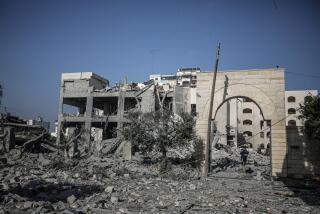In the Silence of Libraries, Tiny Armies Are Munching Away at Human Knowledge
ROME — In the silence of libraries, in the dark, dust and damp of archives, 20 species of insects and 200 types of microorganisms are quietly flourishing and feeding on human knowledge.
From lichen and fungi to termites, beetles and the aptly named book louse, they attack anything from parchment to plastic.
“Hundreds of millions of volumes are in danger,” said Fausta Gallo, director of the Central Institute for the Pathology of the Book in Rome, which recently mounted an exhibition to highlight the difficult and obscure battle to save the world’s cultural heritage.
Michelangelo a Victim
Victims of the destruction include a cartoon by Michelangelo in Naples that has been invaded by microorganisms. The same fate has befallen a self-portrait by Leonardo da Vinci in Turin. And a manuscript by Pierra della Francesca is covered with water marks.
The priceless 9th-Century illuminated Bible of Charles le Chauve, the bald king of France, which is kept in the church of San Giovanni in Laterano in Rome, is slowly decaying from the effects of bacteria.
One major culprit is the beetle family, the Blattella germanica, whose species grow 10 millimeters to 15 millimeters in length, and their larger relation, the Periplaneta americana, 28 millimeters to 44 millimeters long.
Black Blotches
They munch their way through paper, leather and parchment, leaving black blotches shaped like commas.
The silverfish likes paper and linen. But it has a special fondness for the pure cellulose of old paper and for photographs, which it can devour whole, eating both the paper mount and gelatin coating.
The book louse--yellowish, gray or brown in color and one to two millimeters in length--is also prevalent and feeds on the equally common fungi.
But the No. 1 enemy is the termite. Shunning the light, they burrow their galleries inside the book, which looks intact from the outside.
‘Nothing Is Safe’
“But when you pick it up, it disintegrates into dust,” Gallo said. “Nothing is safe from them: wood, paper, material, leather, parchment, bone, ivory, horn and even plastic.”
The larvae of coleopteran beetles--wood mites and wood worms--also have devastating appetites. They eat through leather bindings, cloth, paper and wood.
The majority of microorganisms that attack books are fungi, among which penicillin, origin of the first antibiotics, is the chief offender. It is blamed for 30% of all ailments suffered by books or archives. Inexplicably, it has a marked preference for the first and last pages of a work, and for the bindings.
But man is probably more destructive still. In World War II, 2.5 million volumes were destroyed by fire in France, 5.3 million in Germany, 1 million in Britain and nearly 3 million in Italy. The latter included 39,000 manuscripts, 376 incunabula (books printed before 1500) and 20,000 precious 16th-Century editions, the first after Johannes Gutenberg invented printing from movable type.
Disasters Take Toll
Natural disasters have also taken their toll. Two million volumes were submerged in catastrophic floods in Florence in 1966. In 1904, 20,000 volumes were lost in an earthquake in Messina, and the entire archives of Campania disappeared in the 1980 earthquake in Naples.
Italy, because of the richness of its heritage, is at the forefront of research in conservation. The pioneering Central Institute for the Pathology of Books was founded in 1938. Its 100 experts, equipped with laboratories and a library, develop strategies to prevent and cure book ailments, working closely with similar institutes around the world. These “book doctors” have armed themselves with all the latest advances in technology.
More to Read
Sign up for our Book Club newsletter
Get the latest news, events and more from the Los Angeles Times Book Club, and help us get L.A. reading and talking.
You may occasionally receive promotional content from the Los Angeles Times.







